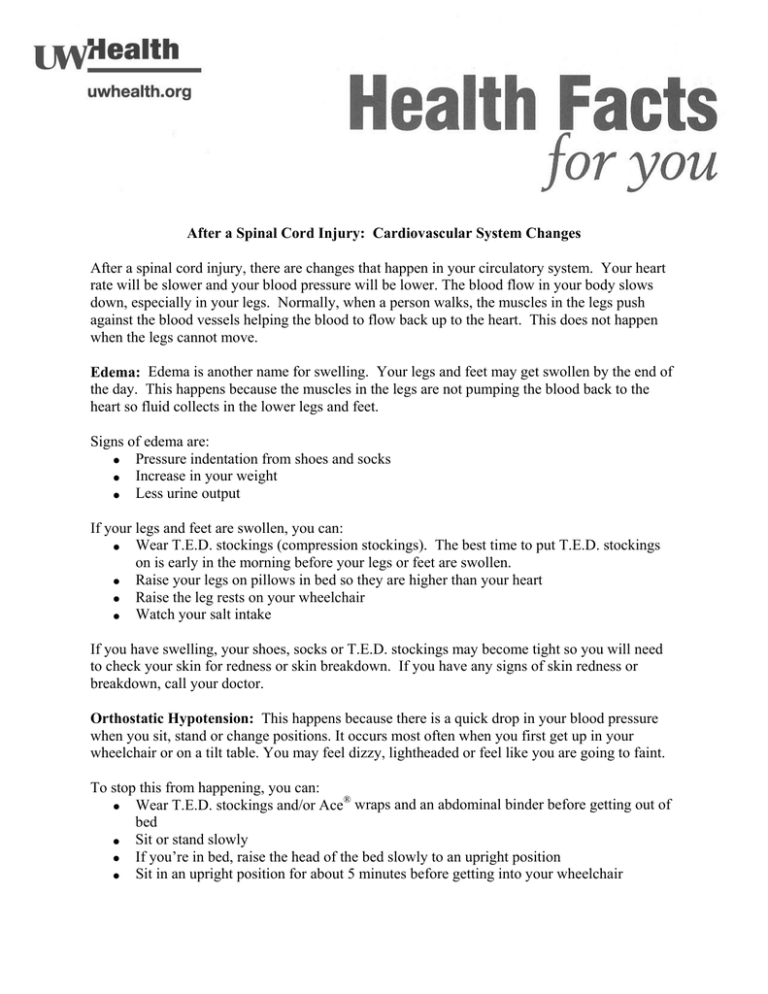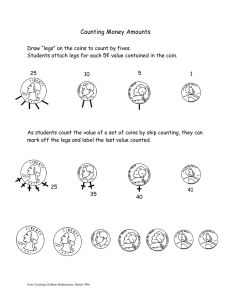
After a Spinal Cord Injury: Cardiovascular System Changes
After a spinal cord injury, there are changes that happen in your circulatory system. Your heart
rate will be slower and your blood pressure will be lower. The blood flow in your body slows
down, especially in your legs. Normally, when a person walks, the muscles in the legs push
against the blood vessels helping the blood to flow back up to the heart. This does not happen
when the legs cannot move.
Edema: Edema is another name for swelling. Your legs and feet may get swollen by the end of
the day. This happens because the muscles in the legs are not pumping the blood back to the
heart so fluid collects in the lower legs and feet.
Signs of edema are:
Pressure indentation from shoes and socks
Increase in your weight
Less urine output
If your legs and feet are swollen, you can:
Wear T.E.D. stockings (compression stockings). The best time to put T.E.D. stockings
on is early in the morning before your legs or feet are swollen.
Raise your legs on pillows in bed so they are higher than your heart
Raise the leg rests on your wheelchair
Watch your salt intake
If you have swelling, your shoes, socks or T.E.D. stockings may become tight so you will need
to check your skin for redness or skin breakdown. If you have any signs of skin redness or
breakdown, call your doctor.
Orthostatic Hypotension: This happens because there is a quick drop in your blood pressure
when you sit, stand or change positions. It occurs most often when you first get up in your
wheelchair or on a tilt table. You may feel dizzy, lightheaded or feel like you are going to faint.
To stop this from happening, you can:
®
Wear T.E.D. stockings and/or Ace wraps and an abdominal binder before getting out of
bed
Sit or stand slowly
If you’re in bed, raise the head of the bed slowly to an upright position
Sit in an upright position for about 5 minutes before getting into your wheelchair
If you are in a wheelchair, have someone tilt the wheelchair back until your head and neck are
almost parallel to the floor. Once you feel better, gradually come back to a sitting position. This
will help raise your blood pressure and the faint feeling will go away.
.
Temperature Regulation: A person that does not have a spinal cord injury is able to keep their
body temperature at about 98.6°F. When it’s hot, their body cools off when they sweat. When it
is cold, they shiver which helps keep the body warm. When a person has a spinal cord injury,
their body temperature will change based on the temperature of the environment.
Hot Weather: The paralyzed part of your body does not sweat so you can easily overheat on a
hot humid day, when sitting in a hot car too long or if you have too many blankets on.
Signs that you are overheated:
Skin feels hot, dry and appears pink or red
High body temperature
Pulse is fast and may be weak and irregular
Feel dizzy
Feel weak
Headache
Feel sick to your stomach
Things you can do to help prevent getting overheated:
Stay out of direct sunlight
Wear light-weight clothes
Wear a hat
Drink plenty of water
Place a cold wet towel around the back of your neck
Bring a spray bottle to spray water on your body to cool off
If you get overheated:
Get out of the sun or hot room
Go to a cool place
Drink plenty of water; do not drink fruit juices, alcohol or caffeine
Sponge off with cool water; shower if possible
Lay down until you feel better
Go to the hospital if you do not to feel better
Cold Weather: The paralyzed part of your body does not shiver so your body can get too cold.
Your feet and fingers can get frostbitten. You may get too cold if you are out in cold weather
without warm clothes, sit in a cold car too long or from being in cold water for too long.
Signs that you are too cold:
Drop in body temperature
Cold, red or pale skin
Fast heart rate
Slow breathing
Confusion
May feel irritable
Loss of interest
Slow, slurred speech
Feel tired
Clumsy movements
Things you can do to prevent getting too cold:
Do not stay in cold weather or cold places too long
Dress warm; layer clothing
Wear warm socks
Winter jacket
Wear a hat
Wear gloves or mittens
Wear boots or shoes
Drink warm fluids
If you get too cold, you can do the following:
Go to a warm place
If your clothes are wet, take them off
Dry your body if it’s wet
Put on layers of warm clothes
Put on a hat
Cover up with blankets
Place a heating pad (set on low heat) or warm compresses on your chest, stomach, groin
or neck; use towel between pad/compresses and your body
Take your temperature
Go to the hospital if your body temperature is low or if your symptoms do not get better
.
Copyright 11/2013. University of Wisconsin Hospitals & Clinics Authority. All rights reserved. Produced by the
Department of Nursing. HF#7578




